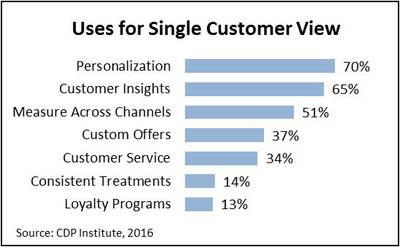Five Reasons to Leave Your Marketing Service Provider for a Customer Data Platform
February 22, 2017 Marketing Service Providers (MSPs) are the old guard of omni-channel customer data management, but they have lost ground in recent years to the dramatically more agile and accessible approach of Customer Data Platforms (CDPs) like AgilOne. For many brands, the question of switching from an MSP to a CDP is a matter of when, not if. The top five reasons for the switch are that brands want:
Marketing Service Providers (MSPs) are the old guard of omni-channel customer data management, but they have lost ground in recent years to the dramatically more agile and accessible approach of Customer Data Platforms (CDPs) like AgilOne. For many brands, the question of switching from an MSP to a CDP is a matter of when, not if. The top five reasons for the switch are that brands want:
1. Direct access to their data
2. A platform based approach to managing customer data
3. Expertise in both digital and offline marketing
4. Future-proofing
5. Lower TCO on their marketing investments
Let’s dive into how CDPs are different from MSPs in each of these five areas.
Access to data
CDPs give marketers direct access to first party data, which is open and accessible. Marketers can easily explore data on an ad hoc basis, and easily connect their data with third party systems without additional contracts. This open access lets marketers more freely leverage data for marketing, enabling more relevant customer engagement and increasing marketing ROI.
MSPs directly manage their clients’ first party data, which creates a “black box” for their clients. Data requests must go through the MSP, and these requests are typically handled on a case-by-case basis. This causes lengthy wait times for accessing data, creates additional costs, and hinders the ability for marketers to fully leverage customer data for personalized engagement.
Technology platform
CDPs are built on a rich SaaS platform with cutting edge big data technology. This platform-based approach allows for continuous updates with new features and capabilities always being added.
MSPs typically combine some technology and services. An MSP does not typically develop technology themselves, but instead relies on a partner community to provide different features. This can result in a random mix of different, sometimes antiquated technologies, and the MSP approach can cause an over-reliance on services—again, increasing costs and creating a barrier to data.
Digital/offline marketing
CDPs that focus on the enterprise offer a single platform for both online and offline data. This is essential for brands that rely on direct mail and catalog revenue streams. For these brands, a CDP should be able to ensure the accuracy and quality of the direct mail database, and let marketers send direct mail to intelligent customer segments that leverage a complete digital/offline customer profile.
MSPs typically do not include offline data sources as part of their customer profile, and they typically do not provide direct mail database services. This causes marketers to leverage separate services for direct mail, and there is no unity or consistency across channels.
Future-proofing
CDPs are inherently future-proofed because CDPs are platform-centric, not services-centric. This means that as a brand’s marketing needs evolve, and as the marketing technology landscape evolves, the a CDP will always stay lock-step with any changes on the horizon. Also, an enterprise CDP can easily scale to meet new demand, and be easily configured to meet new requirements.
MSPs create custom solutions for specific use cases in specific moments in time. As needs change, MSPs respond to change by building new custom systems. This places limits on how a brand can re-envision its marketing strategy, reduces a brand’s ability to be nimble, and makes any changes a brand chooses to implement a heavy burden for the organization.
Lower total cost of ownership (TCO)
CDPs typically have a pricing structure that is predictable and that allows marketers infinite flexibility and configurability without additional costs. This keeps the TCO low no matter how a brand’s needs evolve.
MSPs typically become more expensive based on the customization of a solution. One-off requests such as new data pulls, new reports, or new integrations typically incur additional charges. This keeps the TCO high, especially as brands grow and evolve.
Summary
Once upon a time, enterprise B2C marketing and CRM teams engaged with MSPs to optimize analytics programs, stitch data together, and attempt to orchestrate personalization across channels. But today, enterprises are trading up for the ROI of CDPs, which provides a more agile and accessible alternative to the legacy, services-heavy, request-driven engagements that are the hallmarks of MSPs.


